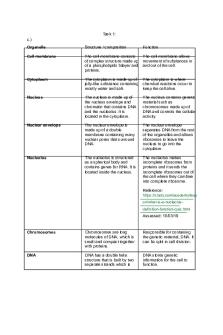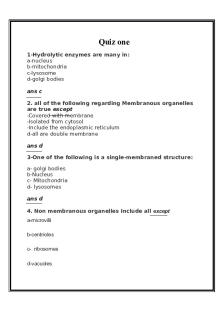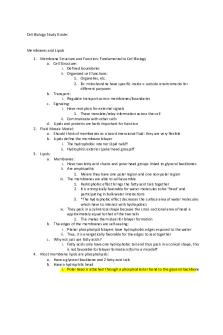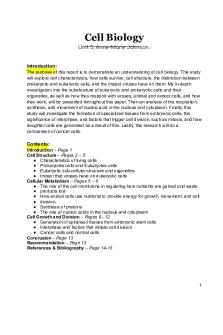Apoptosis - Summary Cell Biology PDF

| Title | Apoptosis - Summary Cell Biology |
|---|---|
| Course | Cell Biology |
| Institution | University of Victoria |
| Pages | 4 |
| File Size | 189.8 KB |
| File Type | |
| Total Downloads | 2 |
| Total Views | 181 |
Summary
Summary of Apoptosis (Proteins, Types, etc.)...
Description
Apoptosis 1) Apoptosis – Type I cell-death (“falling off”) Shrink/condense Cytoskeleton collapses Nuclear envelope disassembles Chromatin condenses & fragments Blebs – apoptotic bodies (altered surface) Macrophage engulf Blebs (no mess) Default in most cells 2) Autophagic – Type II cell-death Cytoplasmic – characterized by formation of large vacuoles which eat away organelles in specific sequence prior to the nucleus being destroyed 3) Necrosis – Type III cell-death Swelling Bursting Mess inflammatory response Other types: 4) “Non-apoptotic programmed cell-death” – “Caspase-independent programmed cell-death” As efficient as apoptosis & can function as either backup mechanisms or main type of PCD 5) Anoikis – almost identical to apoptosis except its function 6) Cornification – a form of cell death exclusive to eyes 7) Excitotoxicity 8) Wallerian degeneration PCD 1st proposed in 70s, not agreed upon until 20 yrs later (C. elegans) Purpose 1) Development – fingers (modeling shape – tail falls off) 2) Eliminate abnormal cells – immune system (neutrophils) Self Ag in immune system – 1011 neutrophils die in a few days to find correct cells 3) RAPID TURNOVER – more cells produced than can be supported by survival factors 4) Cells altered by cancer, or infection (rapid response to infection) 5) Death Rate = Replication Rate – balanced cell death & cell renewal Liver stays same size Phenobarbitol (sedative & hypnotic) stimulates replication growth (reversible) Can be characterized biochemically – fragmented DNA can be observed by gel electrophoresis TUNEL – TdT-mediated dUTP Nick End Labeling Nicking of DNA occurs at linker regions b/w nucleosomes (ladder) TdT = terminal deoxynucleotidyl transferase adds labeled dUTP to 3’-OH of DNA Phosphatidyl Serine (PS) – normally resides on cytoplasmic leaflet of lipid bilayer in PM *During apoptosis – flipped to outer leaflet (ECS) Signals macrophages to phagocytose apoptotic body (Macrophages will eat “eat me” signals or no signals) PS-dependent phagocytosis inhibits usual production of cytokines (immune signals) by phagocytic cells (prevent inflammatory response) Can be detected on outer membrane w/ labeled version of Annexin V (protein, normally binds PS on cyto side) Mitochondria – during apoptosis, membrane potential across inner membrane often lost Cytochrome c cross intermembrane space into cytoplasm (Cyto-c-GFP & mito stain = co-localized) (after UV cyto-c-GFP & anti cyto-c combined – diffuse)
Wnt, hedgehog = development Caspases – family of proteases with cysteine at active site (cleave at specific aspartic residues) Required for apoptosis C = cysteine, Asp = aspartic acid *Synthesized as inactive procaspases then undergo proteolytic cleavage event performed by another caspase become active Inactive procaspases proteolytic cleavage event active Apoptosis machinery always in place – in (in)active form 2 types: 1) Initiator procaspases – e.g. Caspases 2, 8, 9, 10 External signal assembly of procaspases into activation complexes activation (cleave each other) 2) Executioner procaspases – e.g. Caspases 3, 6, 7 Activated by activated initiator caspases Caspase cascade death signal Targets (inactive form caspase active form) Nuclear lamins Cytoskeletal components Cell-cell adhesion proteins (removal of cell-cell adhesion – round up cells) Easier targets for macrophages or extrusion from neighbouring healthy cells (i.e. in skin) DNA endonuclease Inhibitors of Apop: Decoy receptors – ligand-binding domain, no death domain FLIP – intracellular protein resembling initiator procaspases but lacking proteolytic activity *Competitor for binding sites no death FLIP blocks activation of caspase 8 Caspase Cascade – once activated amplifies proteolytic cascade (irreversible) 2 pathways activate caspase cascade: 1) Extrinsic Pathway Death inducing signaling complex (DISC) initiator caspase executioner caspase (3) (some intrinsic) Death receptors can trigger non-apop pathways as well (i.e. TNF receptor can activate NFkB – survival, inflammation response) *Fas receptors – homotrimers FasL = a TNF (tumor necrosis factor) family of signal proteins Stimulated by redox pathways, HIVE, immune system components *Hyperactive killer cells have lots of FasL Killer cells can be NK cells (CD3-) or cytotoxic T-cells (CD3 + CD8+) FADD – Fas Associated Death Domain DISC – Death inducing signaling complex *Multi-protein complex formed by members of death receptor family of apoptosisinducing cellular receptors Typical example – FasR forms DISC upon trimerization as result of its ligand (FasL) binding 2) Intrinsic Pathway Usually in response to stress, lack of oxygen, or injury Mammals – activation of pathway dependent upon release of mitochondrial intermembrane proteins Cytochrome c – important mediator, soluble protein Binds & activates Apaf1 (protein – Apoptotic Protease Activating Factor-1) Apoptosome – heptamer of Apaf1 CARD – Caspase Activation & Recruitment Domain Cyt c = small heme protein found loosely associated with inner membrane of mito Belongs to cyt c family of proteins
Highly soluble protein (unlike other cytochromes) Can catalyze several reactions (i.e. hydroxylation & aromatic oxidation, shows peroxidase activity) Release of small amounts leads to interaction w/ IP3 receptor (IP3R) on the ER, causing ER calcium release Have to control cytochrome c release – done with Bcl2 family of proteins Bcl2 Family – 1st ID’ed as mutant that promotes cancer by inhibiting apop Bcl = B cell lymphoma Pro-apop & anti-apop Form heterodimers with each inhibiting activity of the other Balance b/w them determines if cell lives/dies Controls cytosolic cyt c Highly conserved 3 Classes: a) Pro-Apoptotic Effector Bcl2 Family Members – Bax & Bak Members of BH123 family Bak – always tightly bound to MT outer membrane (even w/o apop signal) Bax – cytosolic & translocates to MT membrane with apoptotic signal *Activation of Bak/Bax depends on activated pro-apoptotic BH3-only *Active intrinsic pathway b) Anti-Apoptotic Bcl2 Protein *Inactive intrinsic pathway Mainly cytoplasmic leaflet of mito outer membrane, ER, nuclear envelope Inhibits BH123 activation Preserve membrane integrity Help prevent release of mito proteins & release of Ca 2+ from ER > 5 types in mammals (need at least 1 to survive) Must be inactivated by inhibitors from BH3-only Bcl2 family for intrinsic pathway to proceed Absence of apop stimulus – bind & inhibits BH123 c) Pro-Apoptotic BH3-Only Proteins – largest subclass of Bcl2 proteins *Active intrinsic pathway Produced/activated by apop stimuli May bind directly to Bax & Bak to assist their activation Different stimuli activate different BH3-only proteins: a) Bim: JNK (MAP kinase) Bim transcription intrinsic pathway b) Puma & Noxa: DNA damage increase in p53 transcription Puma/Noxa intrinsic pathway (stop cancer) c) Bid: Casp 8 cleaves Bid tBid Mt inhibits Bcl2 & triggers apoptosis (BH123) *Links intrinsic & extrinsic pathways *Bad & Bim can form heterodimers with anti-apop Bcl2 BCL-XI prop-apop activity Presence of apop stimulus: BH3-only activated & bind to anti-apop Bcl2 they no longer inhibit BH123 BH123 activate & aggregate & promote release of intramembrane mito protein into cytosol Inhibitors of Apop (IAPs) – inactive intrinsic pathway *1st found in insect viruses (70aa repeat) – to stop insect cell from killing itself when infected (viral protection mech) In cytosol – bind & inhibit active caspases Some = ubiquitin ligases (polyubiquitinate caspases proteasome) In absence of apop stimulus IAP prevent accidental apop caused by random activation of procaspases (E.g. Survivin & Livin – humans) Activation of Intrinsic Pathway (as a whole) Anti-IAPs block IAP active caspase (for apop to proceed, threshold of active caspases must be exceeded) Names include: Hid, Grim & Reaper (Droso), XIAP & Smac/DIABLO in mammals (KO’ed in mice = no effect) Apop stimulus activates intrinsic pathway:
Release of anti-IAP proteins via activated BH123 proteins bind & block IAPs At same time: Release of cyt c via activated BH123 proteins assembly of apoptosomes activate caspase cascade apop Survival Factors – required 1) Suppress apop by stimulating transcription of genes that encode the anti-apop Bcl2 proteins (i.e. Bcl2 & Bcl-X) 2) EC factors can activate serine/threonine protein kinase Akt phosphorylates & inactivates BH3-only pro-apop Bcl2 protein Bad *When not phosphorylated Bad promotes apop by binding to & inhibiting Bcl2 *Once phosphorylated Bad dissociates Bcl2 free to inhibit apop 3) Inhibit apop by stimulating phosphorylation of anti-IAP protein Hid *When not phosphorylated Hid promotes cell death by inhibiting IAP * Once phosphorylated Hid no longer inhibits IAPs IAPs become active & block apop
SUMMARY 1) 2 types of caspases involved – initiator & executioner (both = proteases w/ cysteine in active site that cleaves specific aspartic acid residues) 2) Intrinsic pathway stimulated by cyt c release from intermembrane space of mito – mediated by pro- & anti-apop members of Bcl2 family 3) Intrinsic pathway also + affected by BH3-only Bcl2 subfamily members & anti-IAPs and is inhibited by IAPs...
Similar Free PDFs

Apoptosis - Summary Cell Biology
- 4 Pages

Cell biology summary notes website
- 33 Pages

Cell biology
- 3 Pages

Cell Biology Quiz CELL ORGANELLES
- 10 Pages

Cell Biology Study Guide
- 37 Pages

Cell Biology unit (5)
- 14 Pages

Cell Biology Syllabus 2019
- 5 Pages

Cell biology exam, answers
- 11 Pages

Cell biology lecture notes
- 108 Pages

Adam\'s Cell Biology- Exocytosis
- 4 Pages

Cell biology and genetics
- 12 Pages

Cell biology revision notes
- 5 Pages

Unit 5 Cell Biology
- 18 Pages
Popular Institutions
- Tinajero National High School - Annex
- Politeknik Caltex Riau
- Yokohama City University
- SGT University
- University of Al-Qadisiyah
- Divine Word College of Vigan
- Techniek College Rotterdam
- Universidade de Santiago
- Universiti Teknologi MARA Cawangan Johor Kampus Pasir Gudang
- Poltekkes Kemenkes Yogyakarta
- Baguio City National High School
- Colegio san marcos
- preparatoria uno
- Centro de Bachillerato Tecnológico Industrial y de Servicios No. 107
- Dalian Maritime University
- Quang Trung Secondary School
- Colegio Tecnológico en Informática
- Corporación Regional de Educación Superior
- Grupo CEDVA
- Dar Al Uloom University
- Centro de Estudios Preuniversitarios de la Universidad Nacional de Ingeniería
- 上智大学
- Aakash International School, Nuna Majara
- San Felipe Neri Catholic School
- Kang Chiao International School - New Taipei City
- Misamis Occidental National High School
- Institución Educativa Escuela Normal Juan Ladrilleros
- Kolehiyo ng Pantukan
- Batanes State College
- Instituto Continental
- Sekolah Menengah Kejuruan Kesehatan Kaltara (Tarakan)
- Colegio de La Inmaculada Concepcion - Cebu


